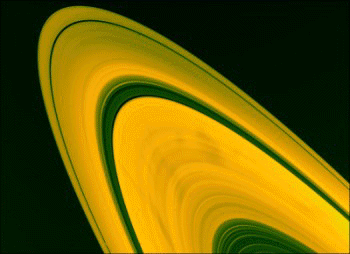
One of the thousands of spectacular pictures sent back by the Voyager missions. This picture shows clearly that Saturn oblates, or stretches out, at its center. This is caused by the facts that Saturn is very light and that it spins very fast.
Saturn is the sixth planet in the solar system, located in between Jupiter and Uranus. Its average distance from the Sun is over 850 million miles, compared to Earth's which is 93 million miles. Saturn's orbit is nearly a circle. The closest the as planet comes to the Sun is around 840 million miles, while the furthest away it gets is around 930 million miles. A year on Saturn is twenty-nine and one-half Earth years! The giant planet spins around, or rotates, once every ten and one-half Earth hours.
Saturn is easy to pick out in the sky because it is one of the brightest lights in the sky. Also, the planet has a very faint greenish color that makes it stand out from the rest of the stars in the sky.
Saturn is the second-largest planet in the solar system. Jupiter is the only planet that is bigger. The gas giant is 72 thousand miles in diameter, almost ten times the size of Earth. To put it another way, if you had a ball that was the size of a dime, Saturn would be a little bigger than a soccer ball. In spite of its huge size, Saturn weighs very little. It is a very light gas planet. Saturn is so light, in fact, that it would float in water.
The beautiful rings that are Saturn's most famous feature are absolutely huge. The rings are over 160 thousand miles in diameter. That is two-thirds of the distance from Earth to the Moon! The rings are very, very thin when compared to their width. They average less than fifty feet thick! This explains why the rings seem to disappear when we are looking at Saturn from the edge. If you look closely at the pictures of Saturn on this page and on the other Saturn pages, you will notice that there are several gaps in the rings. If you could get even closer, you would see that even the parts that appear to be solid are not solid at all, but are made up of billions of snowballs, ranging in size from the snowball you throw in winter to ones that are bigger than a house! The gaps in Saturn's rings are caused by the many moons that circle the giant planet. The moons act to keep the rings lined up in the beautiful patterns you see here. One of the bands in Saturn's rings is even braided, much like a pigtail. The Voyager mission sent back pictures of this amazing feature.

Spokes In Saturn's Rings
Spokes In Saturn's RingsYou can clearly see the divisions in Saturn's rings in this picture. What may not be as easy to see are the "spokes" in the rings that look like the spokes on a bicycle wheel. Scientists believe the spokes are caused by the very strong magnetic field around the planet.
Saturn has at least eighteen moons, more than any other planet in our solar system. The Voyager missions took pictures of what might be at least six more moons, but we will have to wait for the Cassini mission for more information. The many moons of Saturn play an important part in keeping the shape of Saturn's spectacular rings. One of Saturn's most interesting moons is Titan. Titan has a very thick atmosphere, or blanket of air, surrounding it. The atmosphere on Titan contains a lot of the gas nitrogen, like what we have here on Earth. Scientists believe that Titan may have liquid water on its surface, which would be an exciting discovery if it turns out to be true. The Cassini space mission will land a probe, or special landing craft, on Titan to try and answer some of these questions.
Saturn was named for the Roman god of agriculture. In Roman mythology Saturn was the father of Jupiter. In our solar system, this is a case where the son outgrew the father. Saturn is also the root, or origin, of our word "Saturday".
Saturn is a lot like Jupiter, in that it is a gas planet, made of mostly of the elements hydrogen and helium. Saturn is a lot lighter, or less dense, than Jupiter. The combination of its light weight and speedy rotation causes Saturn to spread out, or oblate, at its center. You can see this clearly in some of the pictures of Saturn. Jupiter spreads out at its center, too, like the rest of the gas planets, but not nearly as much as Saturn. If you want an explanation of how a planet can be made of gas, look at the the Jupiter page.
Since Saturn is a gas planet, it does not have a solid surface like Earth does. Landing a spacecraft on Saturn would be like trying to land an airplane on a cloud. The clouds we see when we look at Saturn are just the top layer of a very deep layer that covers a center of liquid hydrogen. The clouds on Saturn are blown by constant winds that can blow at speeds up to one thousand miles per hour at the equator, or center, of the planet. Saturn does have different colored spots, or features, in its clouds, but nothing that is as spectacular as the Great Red Spot on Jupiter.
Back To Main Menu
Use the "BACK" button on your Browser to return to the previous page.